MySQL Interview Questions

Categories:
 Written by:
Written by:Vivek Sankaran
Interview questions to learn MySQL from the basics and get ready for your next Data Science Interview involving the most popular open-source SQL database in the world.
MySQL is one of the most popular databases in use and the most popular open-source database and was named the Database of the Year in 2019. Conceptualized in the mid-1990s, MySQL was initially acquired by Sun Microsystems, which in turn was acquired by Oracle Corporation. MySQL is built on C and C++ and works on multiple platforms - Windows, Mac, Linux. It is available both in GNU General Public License as well as Proprietary licenses. MySQL is the M in the LAMP stack used to develop web applications. Here is a brief comparison of the differences between the top SQL flavors.

Unlike Windows SQL server that works only on Windows (obviously!!) and Linux, the other top SQL flavors including MySQL work on all top OS. When it comes to features, MySQL appears to have the least number of features available. However, it is highly unlikely that one will miss these features especially as a Data Analyst or a Data Scientist.
While starting off with learning SQL, MySQL is a good place to start and one should not worry too much about the missing functions. New features and functionalities keep getting added all the time. For instance, suppose you want to find the day of the month from a date value (18 from 18th Sep 2022). Using MySQL, we can simply use the built-in DAY function. However, there is no corresponding function in Postgres. But we can accomplish the same using the EXTRACT function which is present in both the dialects. You can learn about the differences and similarities between MySQL and Postgres in detail here.
Fun Fact: The “My” in MySQL comes from the name of the daughter of Michael Widenius's daughter My. His other two kids, Maria and Max, too have databases named after them.
MySQL for Data Analysts and Data Scientists
In this article, we will look at the application of MySQL from a Data Science and Data Analyst point of view. I would suggest that you also check out our SQL Interview Questions preparation guide and The 30 frequently asked SQL Query Interview Questions to complete your interview preparation for your next data science role. You can solve all these MySQL interview questions and many more on the StrataScratch platform.
Basic MySQL Interview Questions

Let us start from the beginning. Once the data is in the database, we need to start querying it to find the information and insights that we need.
SELECT
The SELECT statement is the heart of SQL. As the name suggests, it simply fetches the information. We can perform mathematical operations.
SELECT 2 + 3;
We can find the current date
SELECT CURRENT_DATE();
One can also check the version of MySQL available. This is helpful in identifying which functions one can actually use.
SELECT VERSION();
While these return a single value, usually we will be querying a database table. Let us try querying a table.
SELECT FROM
Let us try to query a full table. Since we do not know the column names, we can simply use the * operator to get all the fields. You can try the code on the below MySQL interview question example.
MySQL Interview Question #1: Sort workers in ascending order by the first name and in descending order by department name

Link to the question: https://platform.stratascratch.com/coding/9836-sort-workers-in-ascending-order-by-the-first-name-and-in-descending-order-by-department-name
SELECT * FROM worker;
While this is convenient, one should use SELECT * only when one knows that she will be using all the fields. Further, right now we are extracting the full table. While this table is tiny, in real life, tables can run into billions and trillions of rows and hundreds of columns. If you want to explore the data, use only a few rows.
LIMIT
As the name suggests, the LIMIT clause returns only a specific number of rows. Instead of getting the full results, let us just get five rows.
SELECT * FROM worker
LIMIT 5
;
LIMIT clause is very helpful to research large tables and understand what the data looks like. It can also be used to make sure that the query is correct and fetches the data one actually needs.
Selecting a specific column
Instead of selecting all the columns, most of the time we will need only specific columns. We can do that by specifying the columns in the order that we want in the output. Let us select the department, last_name, first_name, joining_date, and the salary in that particular order.
SELECT
department
, last_name
, first_name
, joining_date
, salary
FROM worker
;
Filtering Data using the WHERE clause
Just as we specify the columns to keep, we can also filter out the rows based on specific conditions. To do this, we use the WHERE clause. Let us try to find all the rows where the salary is greater than 100,000. This is pretty simple.
SELECT *
FROM worker
WHERE salary > 100000
;
We can use multiple filters in the WHERE clause by using AND, OR, and NOT logical operators.
Here are a few examples -
Find workers in the HR or Admin Department.
SELECT
*
FROM worker
WHERE department = 'HR' OR department = 'Admin'
;Find the workers in the Admin department earning a salary lesser than 150,000
SELECT
*
FROM worker
WHERE
department = 'Admin'
AND salary < 150000
;Find all the workers except for those in the HR department.
SELECT
*
FROM worker
WHERE
NOT (department = 'HR')
;Sorting Data
With the SELECT statement, the output rows are not in a specific order. We can order the output in our desired order. Let us sort the rows in the order of their first names. To do this we use the ORDER BY clause.
SELECT
*
FROM worker
ORDER BY first_name
;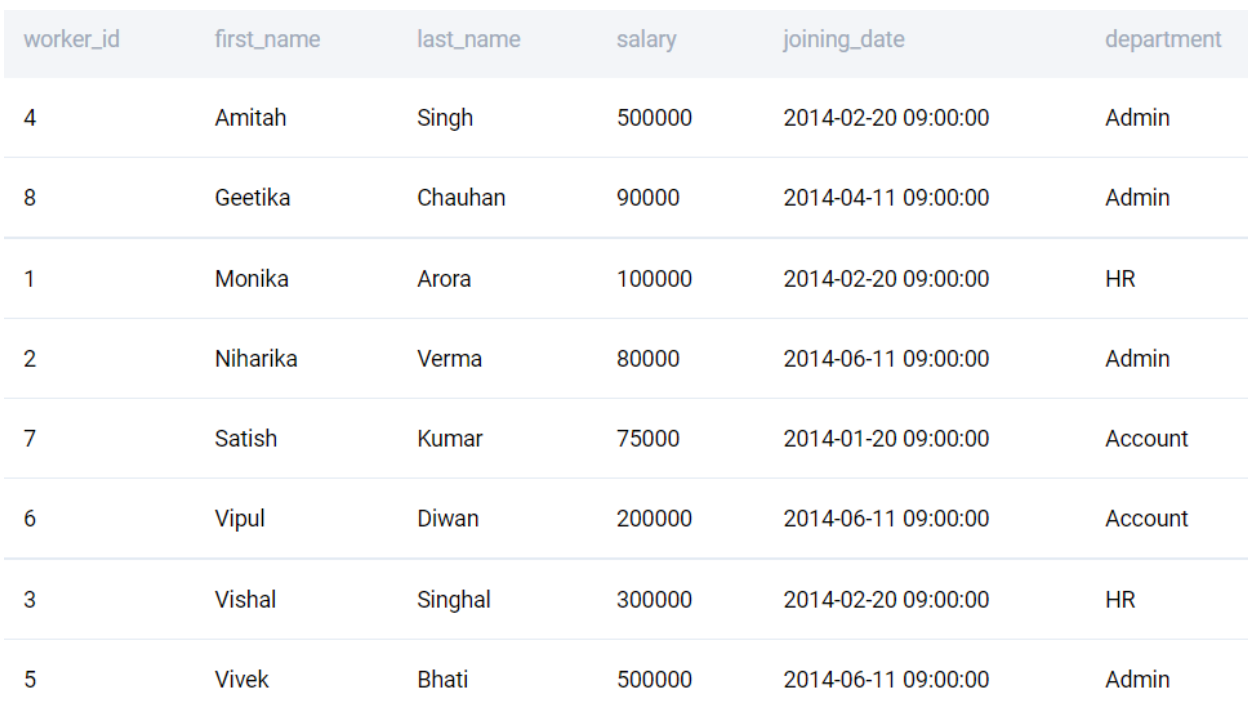
If the order is not specified, it sorts in ascending order. To sort in descending order, we need to specify DESC after the column name. Let us sort the output in the reverse alphabetical order of their first names.
SELECT
*
FROM worker
ORDER BY first_name DESC
;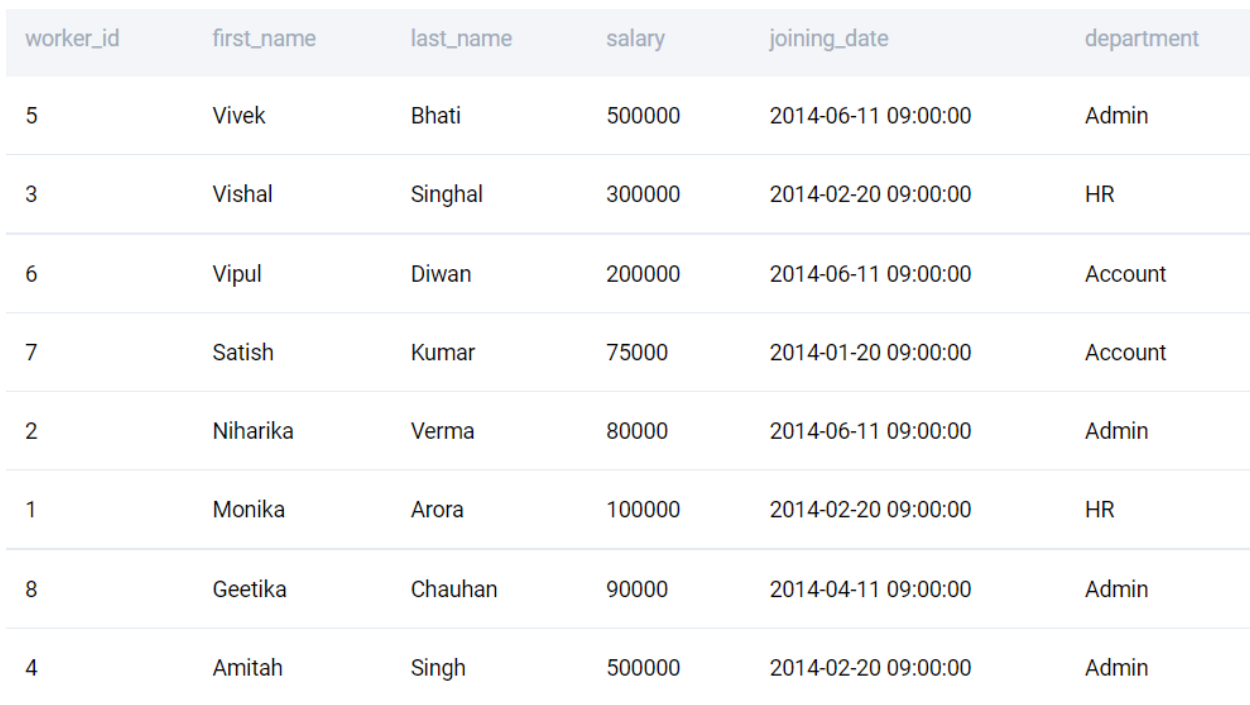
We also specify multiple sorting orders. Let us sort the output in descending order of the salaries and then by the department name in alphabetical order.
SELECT
*
FROM worker
ORDER BY salary DESC, department
;

Instead of specifying the full column name, we can also specify the position of the columns in the output.
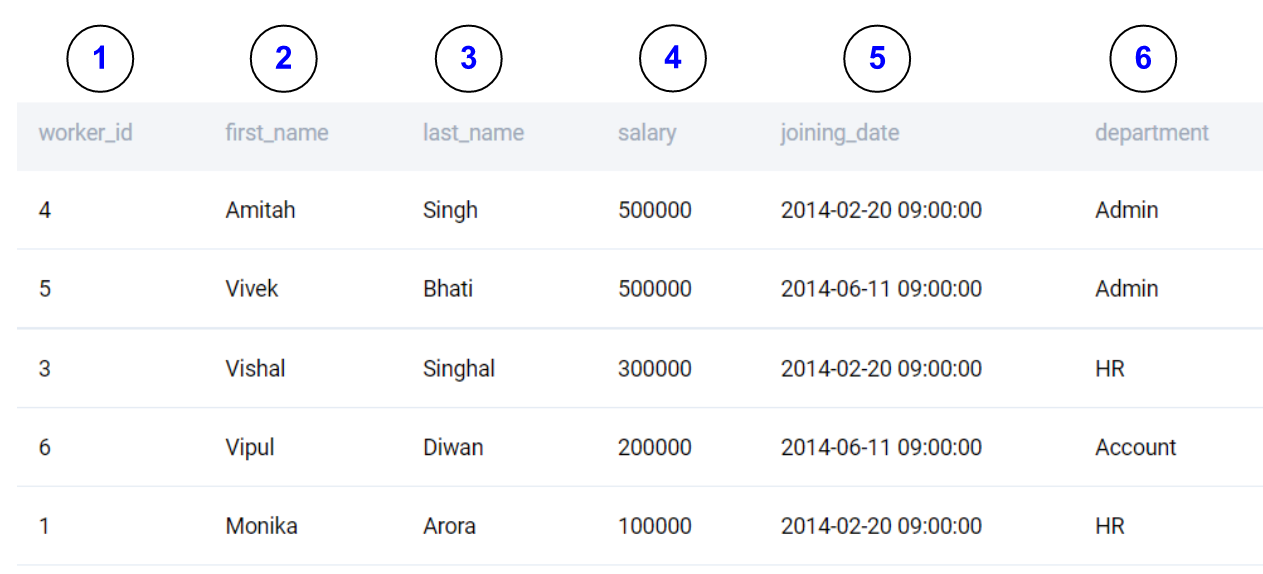
We can get the same output using the following.
SELECT
*
FROM worker
ORDER BY 4 DESC, 6
;You can read more about sorting in SQL in our “Ultimate Guide to Sorting in SQL”.
Finding Unique values
To analyze a dataset, one might want to find the different values that are present in the table. To find the unique values, one can use the DISTINCT clause. The DISTINCT clause can also be used to eliminate duplicate rows. Let us try to find the different departments in the table. To do this, we apply the DISTINCT clause on the department row.
SELECT
DISTINCT department
FROM worker
;
We can also find the different salary values in the dataset.
SELECT
DISTINCT salary
FROM worker
;
If we apply the DISTINCT clause on more than one row, it will find all the unique combinations of the rows in the table. Note this will not give all the possible combinations, just those combinations that are present in the table
SELECT
DISTINCT department, salary
FROM worker
;
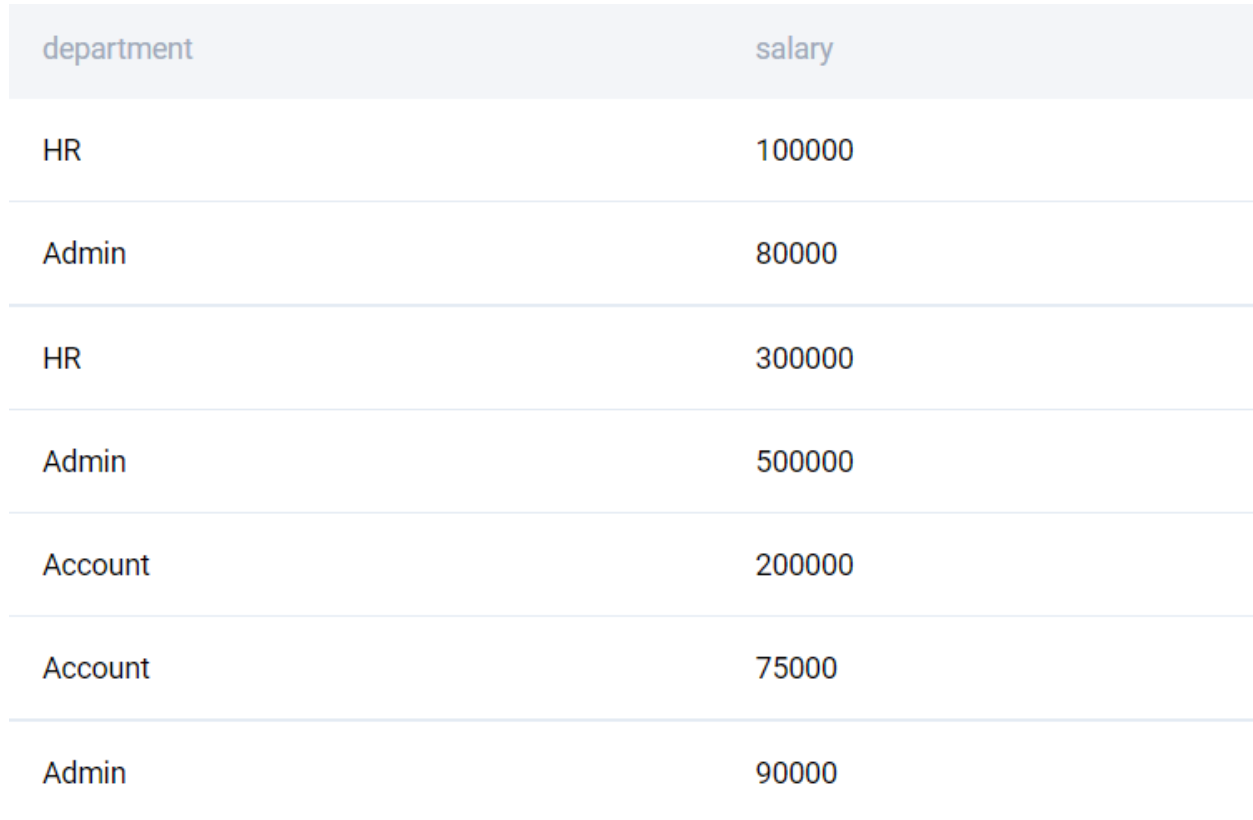
Aggregations
We can also calculate summary values for a given column. The salient aggregate functions available in MySQL are
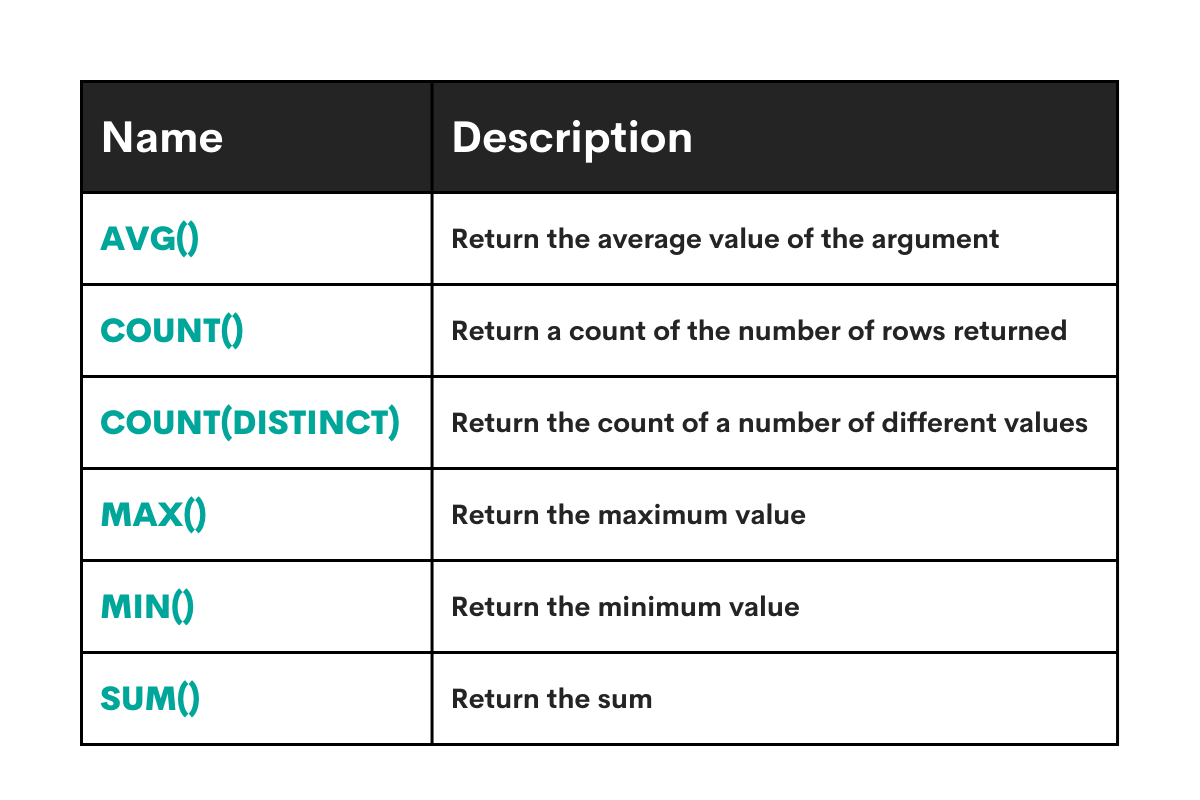
Let us try a few of these.
If we want to find the number of rows in the table, we can simply use the COUNT(*) option. COUNT(*) is the only aggregation function that will consider even NULL values.
SELECT COUNT(*) FROM worker;
We can use COUNT in conjunction with the DISTINCT clause. This will return the number of unique values in the rows.
SELECT
COUNT(DISTINCT department)
FROM worker
;
There are various other aggregation functions for text, JSON, and bit-wise operations in MySQL. The full list of aggregate functions is available here. We have a detailed article on different aggregation functions and their applications here in this ultimate guide “SQL Aggregate Functions”.
Grouping Data
As of now, we have aggregated values for the entire column. We can also calculate aggregate metrics by subcategories. Let us calculate the average salary for each department. Let us start off by calculating the overall average. We can use the AVG() function.
SELECT
AVG(salary)
FROM worker
;
We can now split this by each department by using the GROUP BY clause. As the name suggests, this clause will calculate the aggregate metric for each subcategory.
SELECT
department
, AVG(salary)
FROM worker
GROUP BY 1
;
We can use the WHERE clause in conjunction with the GROUP BY operation. The WHERE clause will subset the data based, and the GROUP BY operation will then be applied to the subset. Suppose we want to consider only those salaries that are lesser than 200,000, we can do it in the following manner.
SELECT
department
, AVG(salary)
FROM worker
WHERE salary < 200000
GROUP BY 1
;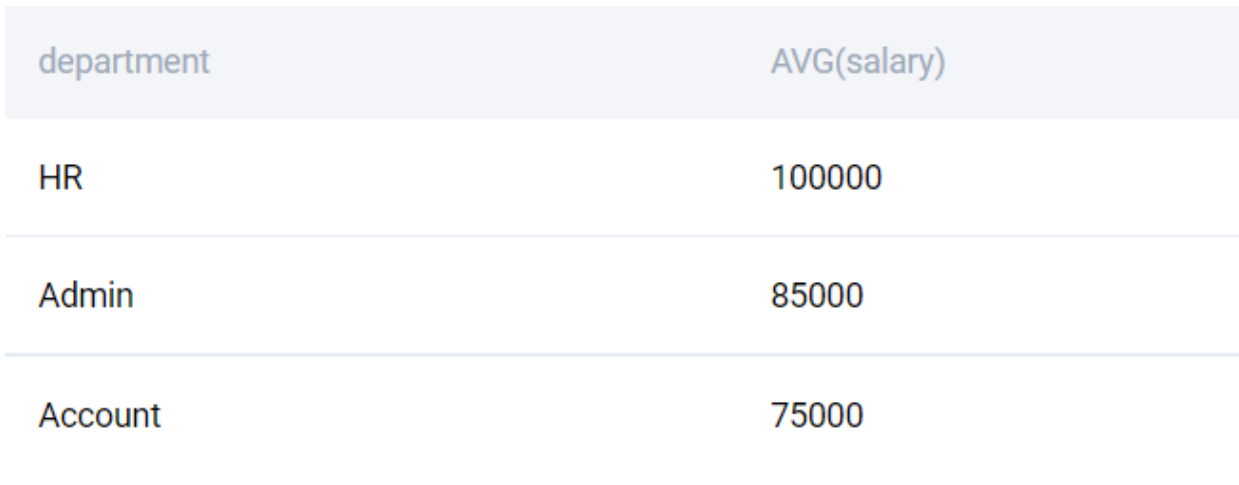
The WHERE condition will return only those records that have a salary lesser than 200,000. We can verify this.
SELECT
*
FROM worker
WHERE salary < 200000
;On occasions, we might want to filter the aggregated value. For example, if we want to find the departments that have an average of more than 150,000. Let us start by finding the average again.
SELECT
department
, AVG(salary)
FROM worker
GROUP BY 1
;
We cannot use the WHERE condition here because it is executed before the GROUP BY clause aggregates based on different subcategories; we shall explain this a bit more later in the article. If we want to filter the aggregated value, we use the HAVING clause.
SELECT
department
, AVG(salary)
FROM worker
GROUP BY 1
HAVING AVG(salary) > 150000
;
WHERE vs HAVING
A very common MySQL interview question is the difference between WHERE and HAVING and when to use them.
MySQL Interview Question #2: WHERE and HAVING
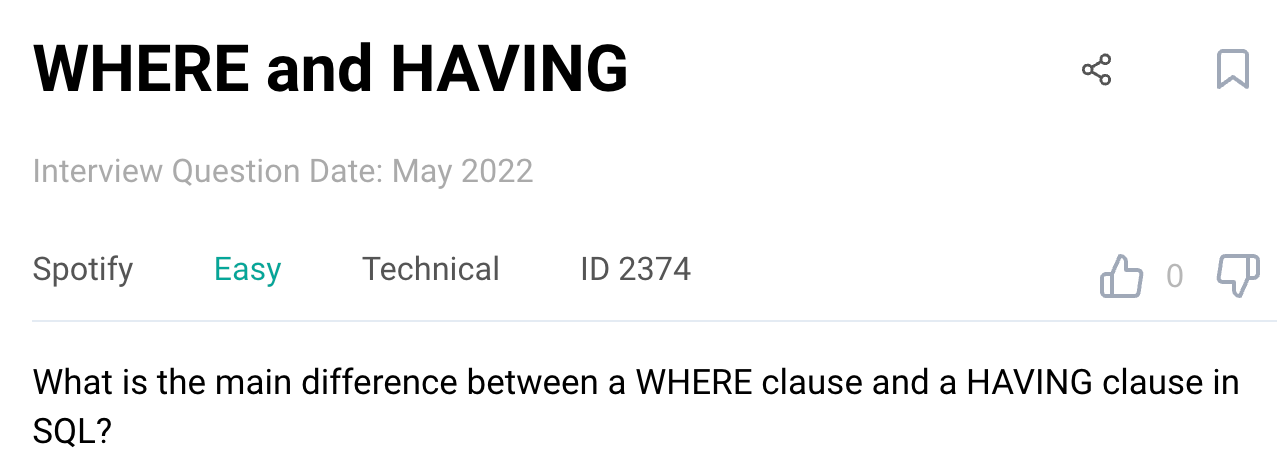
Link to the question: https://platform.stratascratch.com/technical/2374-where-and-having
The difference stems from how MySQL (or any other SQL engine) executes a query.

We cannot use aggregations in the WHERE clause because it is executed before the GROUP BY. On the other hand, since HAVING is executed after the GROUP BY, we must necessarily use an aggregation in the HAVING clause.
ALIASES
It might be useful to be able to rename the output columns to a more readable output. Let us rename the AVG(salary) field in the output.
SELECT
department
, AVG(salary) AS average_salary
FROM worker
GROUP BY 1
HAVING AVG(salary) > 150000
;
Note: we cannot use the ALIAS in the WHERE or the HAVING clause.
If we want spaces or special characters in the output, we need to quote them.
SELECT
department
, AVG(salary) AS "average salary in $"
FROM worker
GROUP BY 1
HAVING AVG(salary) > 150000
;
Intermediate MySQL Interview Questions

Now that we have the basics in place, let us go through the intermediate-level MySQL interview questions and amp up our skills.
Subqueries, CTEs, and TEMP tables
Sometimes it is not possible to get the desired output in a single query. Let us consider the following problem.
MySQL Interview Question #3: Email Details Based On Sends
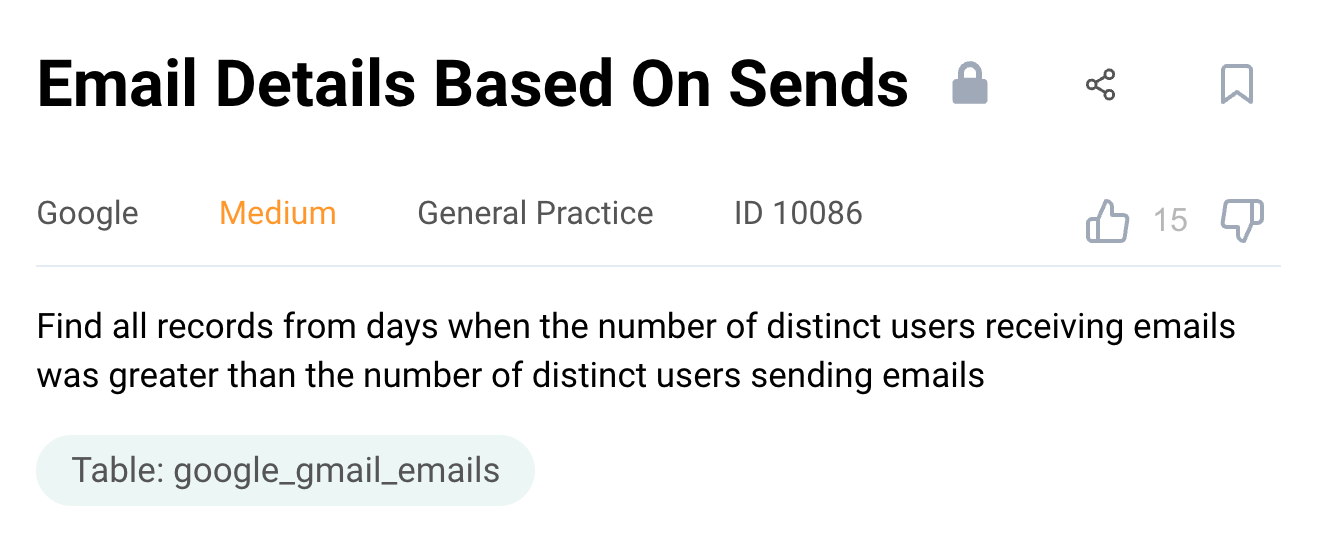
Link to the question: https://platform.stratascratch.com/coding/10086-email-details-based-on-sends
This problem uses the google_gmail_emails table with the following fields.

The data is presented thus.
Solution
We start by finding the number of users sending the emails and receiving them each day.
SELECT
day
, COUNT(DISTINCT from_user) AS num_from
, COUNT(DISTINCT to_user) AS num_to
FROM google_gmail_emails
GROUP BY 1
;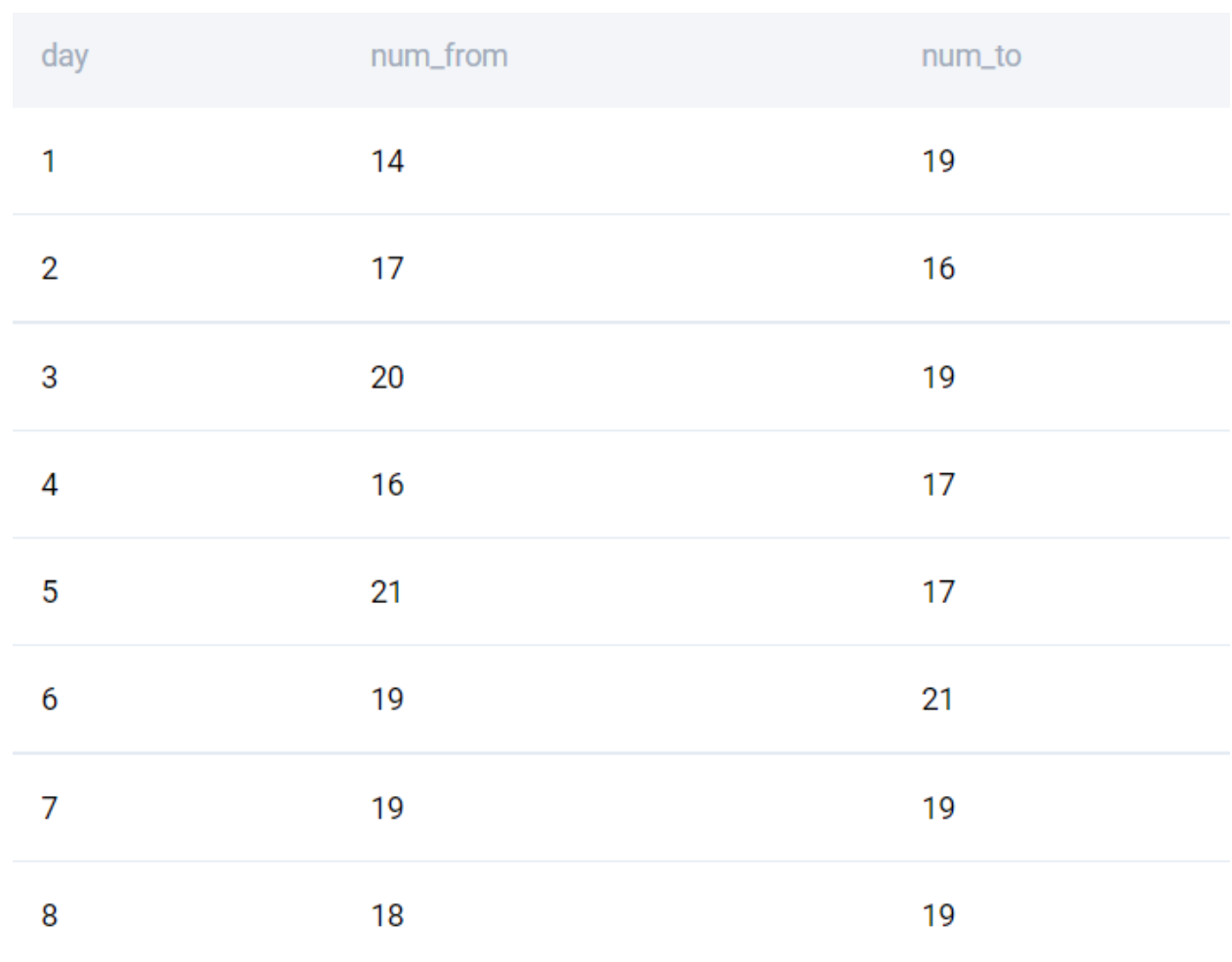
Since we need only those days where the number of users receiving emails is more than the number sending them, we apply the filter using the HAVING clause.
SELECT
day
, COUNT(DISTINCT from_user) AS num_from
, COUNT(DISTINCT to_user) AS num_to
FROM google_gmail_emails
GROUP BY 1
HAVING COUNT(DISTINCT from_user) < COUNT(DISTINCT to_user)
;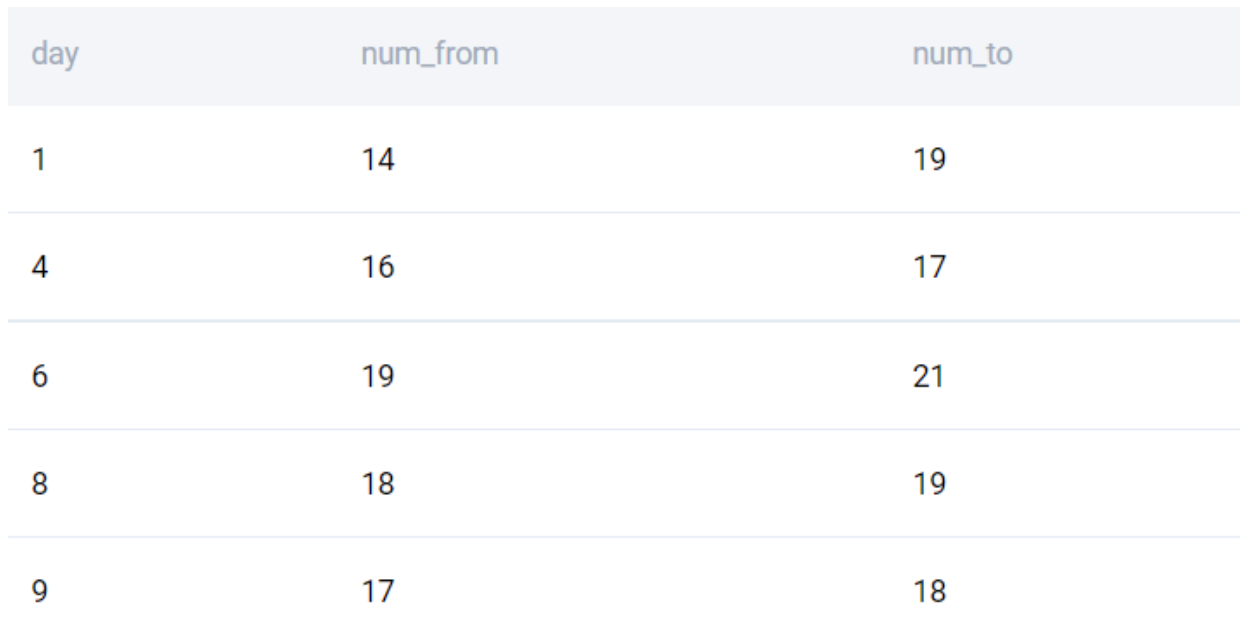
Now we have the days that satisfy the criteria, we simply need to subset the main table for these days. We can do that by listing it out using the IN condition.
SELECT
*
FROM google_gmail_emails
WHERE day in (1, 4, 6, 8, 9)
;While this solves the problem that we have, it is not a scalable solution. This requires us to run the first query, note down the output values, and then modify the query again. If we want to do this dynamically and for a larger table, we will need a way to store the output. There are multiple ways of going about doing this.
Using a Subquery
As the name suggests, we write a query within a query. Let us do this in parts. We start by extracting all the values from the subquery.
SELECT *
FROM (
SELECT
day
, COUNT(DISTINCT from_user) AS num_from
, COUNT(DISTINCT to_user) AS num_to
FROM google_gmail_emails
GROUP BY 1
HAVING COUNT(DISTINCT from_user) < COUNT(DISTINCT to_user)
) AS SQ
;We get the same output as earlier.
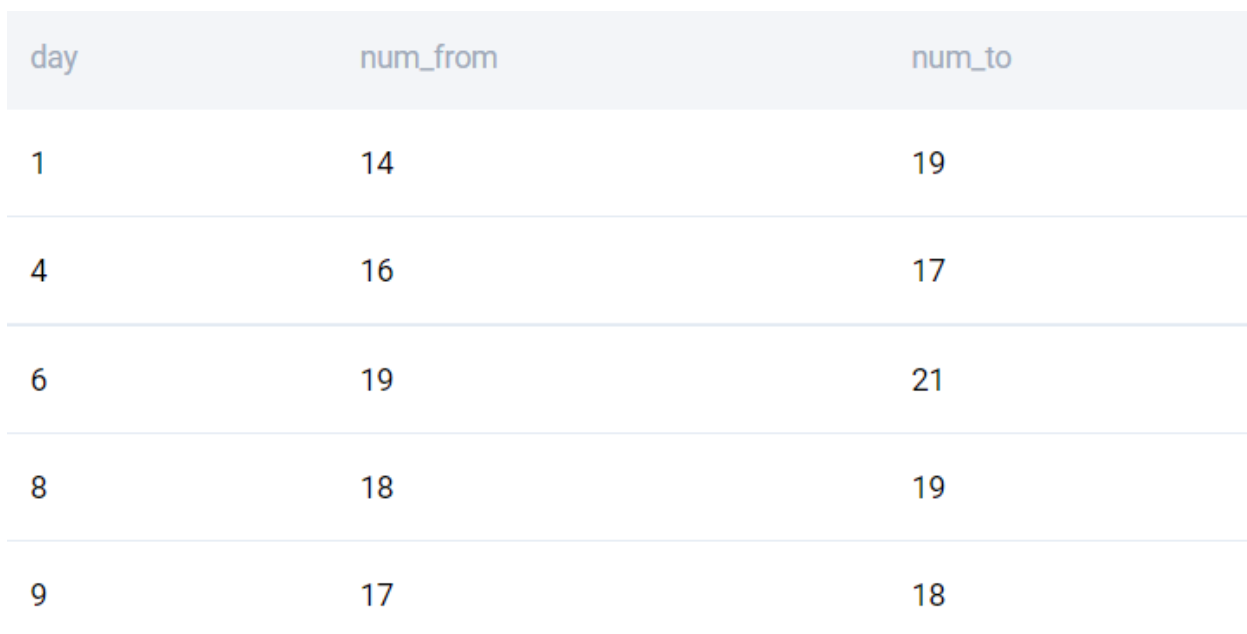
Instead of getting all the values, we simply get the days.
SELECT DAY FROM (
SELECT
day
, COUNT(DISTINCT from_user) AS num_from
, COUNT(DISTINCT to_user) AS num_to
FROM google_gmail_emails
GROUP BY 1
HAVING COUNT(DISTINCT from_user) < COUNT(DISTINCT to_user)
) AS SQ
;

Now we use this sub-query and extract only the relevant days from the main dataset
SELECT
*
FROM google_gmail_emails
WHERE day in (
SELECT
day
FROM google_gmail_emails
GROUP BY 1
HAVING COUNT(DISTINCT from_user) < COUNT(DISTINCT to_user)
)
;We now have the required output.
Using a CTE
Subqueries are very helpful, but as you might have observed, they become very unwieldy for large subqueries, and the code becomes very difficult to read and debug. We can get the same result with a Common Table Expression (CTE).
WITH days AS
(
SELECT
day
, COUNT(DISTINCT from_user) AS num_from
, COUNT(DISTINCT to_user) AS num_to
FROM google_gmail_emails
GROUP BY 1
HAVING COUNT(DISTINCT from_user) < COUNT(DISTINCT to_user)
)
SELECT
G.*
FROM google_gmail_emails AS G
WHERE day in (SELECT day FROM days)
;CTEs work in the same manner a sub-queries. Think of CTEs as SQL tables created on the fly. As we shall see later, we can also JOIN these subqueries and CTEs. Another often used way of using multiple queries is to create a TEMP TABLE.
TEMP Table
As the name suggests a TEMP table is a temporary table that is created in memory. The table is automatically deleted when the SQL session ends.
Note this will return an error on the StrataScratch platform as only Admins have the privilege of creating TEMP Tables.
CREATE TEMP TABLE days AS
SELECT
day
, COUNT(DISTINCT from_user) AS num_from
, COUNT(DISTINCT to_user) AS num_to
FROM google_gmail_emails
GROUP BY 1
HAVING COUNT(DISTINCT from_user) < COUNT(DISTINCT to_user)
;
SELECT
G.*
FROM google_gmail_emails AS G
WHERE day in (SELECT day FROM days)
;One of the additional advantages of a TEMP table is that it can be accessed only by the current session. Therefore there is no problem with conflicts with other parallel sessions. This is particularly helpful when a lot of people are querying the same database concurrently. It prevents other sessions from creating a lock on the table. Another use case for a TEMP table is to store a large amount of data without having to worry about having to delete that table later on when the session ends. One can test large Data Pipelines with TEMP tables without having to run CTEs or subquery each time.
Working with multiple tables
In the real world, it is rare to find all the data present in the same table. It is inefficient and expensive to store all the information in a single table as there might be a lot of redundant information. Further, the complexities of most real-world scenarios mean that it is better to store the information in multiple tables. Ensuring that the database is designed efficiently to reduce redundancies is called normalization.
Normalization
Database normalization is the transformation of complex user views and data stores into a set of smaller, stable data structures. In addition to being simpler and more stable, normalized data structures are more easily maintained than other data structures.
Steps
1st Normal Form (1NF): The first stage of the process includes removing all repeating groups and identifying the primary key. To do so, the relationship needs to be broken up into two or more relations. At this point, the relations may already be of the third normal form, but it is likely more steps will be needed to transform the relations into the third normal form.
2nd Normal Form (2NF): The second step ensures that all non-key attributes are fully dependent on the primary key. All partial dependencies are removed and placed in another relation.
3rd Normal Form (3NF): The third step removes any transitive dependencies. A transitive dependency is one in which non-key attributes are dependent on other non-key attributes.
JOINS
To get information from multiple tables, we can use JOINs. If you are aware of the LOOKUP function in spreadsheets, JOINs work in a similar manner. Unlike a LOOKUP function, we can have multiple different type of JOINs. To illustrate the JOINs let us take a simple problem and understand how JOINs work.
MySQL Interview Question #4: Products with No Sales

Link to the question:
https://platform.stratascratch.com/coding/2109-products-with-no-sales
This problem uses the fct_customer_sales and dim_product tables with the following fields.
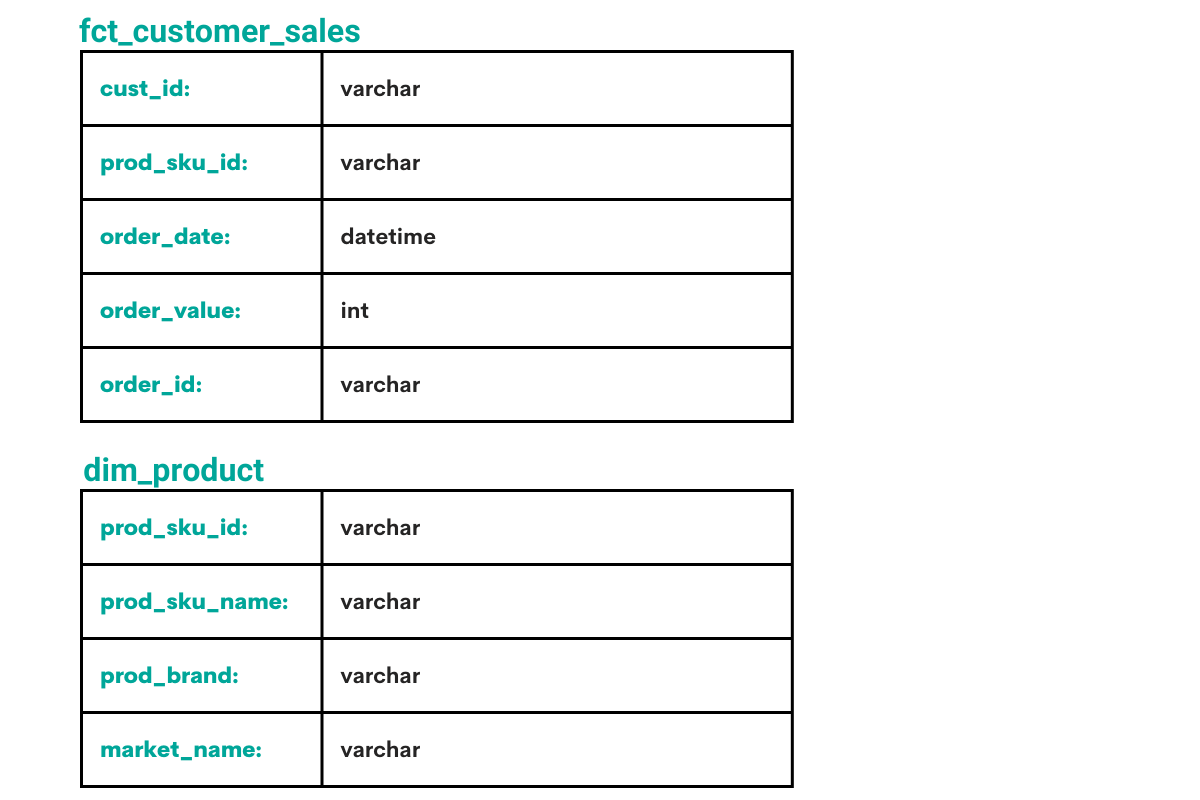
The data in the fct_customer_sales is presented thus.
And the data in dim_product is presented in the following manner.
INNER JOIN
An inner join takes the data present in both the tables. To join the two tables, we need glue or a key. In simple terms, this is an identifier that is present in both tables. As you would have guessed, the common identifier here is the prod_sku_id.
SELECT
fcs.*,
dp.*
FROM fct_customer_sales AS fcs
INNER JOIN dim_product AS dp
ON fcs.prod_sku_id = dp.prod_sku_id
;
As you can see, we get the common rows from both the tables.
LEFT JOIN
The most commonly used join in practice is the LEFT JOIN. The process is similar to the INNER JOIN except, we keep the left table as the base table and keep adding information from other tables to this table. In case there is no information relevant to the key in the other table, NULL rows are returned. In our case, since the product table is the base table, we set to keep the dim_product as the LEFT table. The joining process is essentially the same. However, in this case, the order of specifying the tables matter since we need to set the base (left) table.
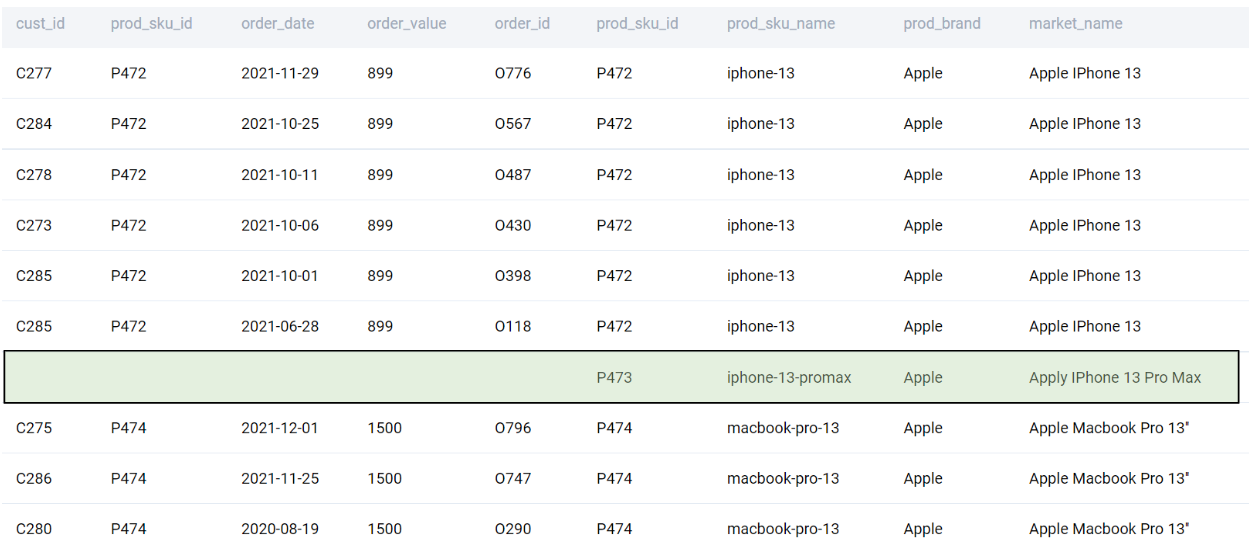
As you can observe, we get NULLs for some rows. Now, these are the rows that are relevant to the solution as we need to get the products that did not have any sales (or matches). We can get the solution by simply subsetting the final output.
SELECT
fcs.*,
dp.*
FROM dim_product AS dp
LEFT JOIN fct_customer_sales AS fcs
ON fcs.prod_sku_id = dp.prod_sku_id
WHERE fcs.prod_sku_id IS NULL
;RIGHT JOIN
The mirror opposite of the LEFT JOIN is the RIGHT join. As you would have guessed, this reverses the joining process. The second (right) table is considered the base table, and the information is appended from the left table. In case there is no information available from the RIGHT table, we will get a NULL row. We can rewrite the solution using the RIGHT JOIN in the following manner.
SELECT
fcs.*,
dp.*
FROM fct_customer_sales AS fcs
RIGHT JOIN dim_product AS dp
ON fcs.prod_sku_id = dp.prod_sku_id
WHERE fcs.prod_sku_id IS NULL
;The choice of LEFT JOIN and RIGHT JOIN, while arbitrary, can sometimes lead to raging online debates, as evidenced here. Without taking any sides, it is customary to use LEFT JOINs though there are scenarios when RIGHT JOINs might make sense. To assuage the religious, just change the order of the tables!!
UNION
One overlooked aspect of joining tables in MySQL is the UNION. Unlike a JOIN which adds columns (fields), UNIONs stack rows. Let us take a simple example, suppose we want to stack names. We can simply do something like this.
SELECT 'VIVEK' AS name
UNION
SELECT 'NATE' AS name
UNION
SELECT 'TIHOMIR' AS name
;
UNIONs, by default eliminate duplicate entries.
SELECT 'VIVEK' AS name
UNION
SELECT 'NATE' AS name
UNION
SELECT 'TIHOMIR' AS name
UNION
SELECT 'VIVEK' AS name
;
If you need duplicates, use UNION ALL
SELECT 'VIVEK' AS name
UNION
SELECT 'NATE' AS name
UNION
SELECT 'TIHOMIR' AS name
UNION ALL
SELECT 'VIVEK' AS name
;
You can read more about JOINs and UNIONs in this comprehensive article about SQL JOINs here.
Built-in Functions in MySQL
Let us now use some of the built-in functions present in MySQL. These functions can be used to perform numerous common tasks like Date and Time manipulation, Text manipulation, Mathematics, et al. Let us look at a few common ones.
Working with Date time functions
Date and time functions are critical in our day to day life. We encounter them every moment of our lives. Date time manipulation is a very commonly asked problem scenario in SQL interviews. Let us look at a few problems.
MySQL Interview Question #5: Users Activity Per Month Day

Link to the question: https://platform.stratascratch.com/coding/2006-users-activity-per-month-day
The problem uses the facebook_posts table with the following fields.

The data is presented in the following manner.
To solve this problem, we need to extract the day of the month from the post_date. We can simply use the DAYOFMONTH() or DAY() function in MySQL to do this.
SELECT
*
, DAY(post_date) AS day_of_month
FROM facebook_posts;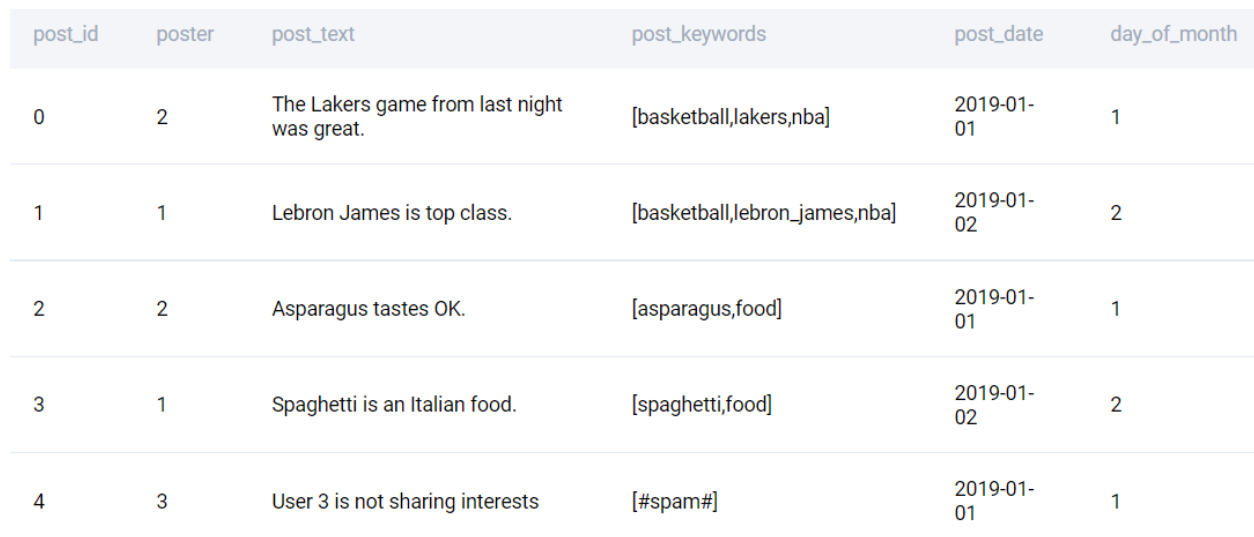
Now we simply aggregate the number of users by each day.
SELECT
DAY(post_date) AS day_of_month
, COUNT(*)
FROM facebook_posts
GROUP BY 1
;Let us try a slightly difficult one that uses more datetime functions.
MySQL Interview Question #6: Extremely Late Delivery

Link to the question: https://platform.stratascratch.com/coding/2113-extremely-late-delivery
This problem uses the delivery_orders table with the following columns.
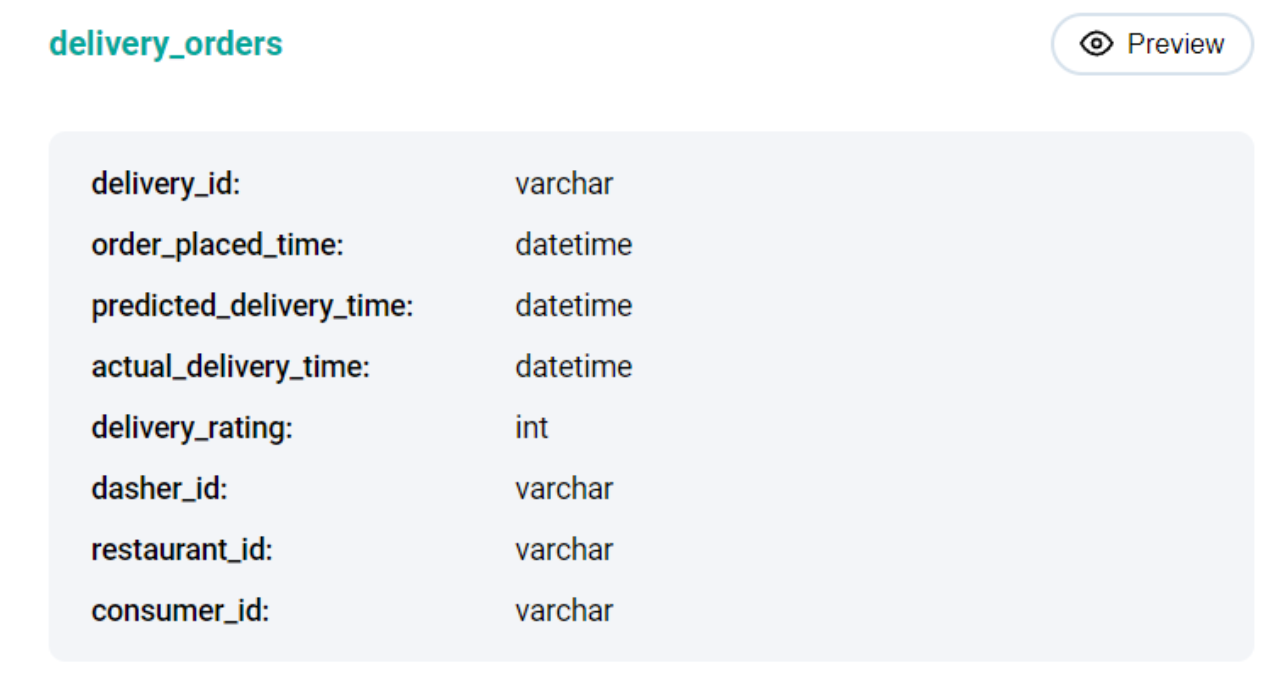
The data is presented in the following manner.
In the problem, we need to perform two datetime manipulations
- Extract the Year and Month from the order_placed_time
- Find the difference in minutes between the actual_delivery_time and predicted_delivery_time
Let us start by extracting the Year and Month. We can use the DATE_FORMAT() function in MySQL. This function converts a given date time value to a string format. We only keep the fields relevant to the solution.
SELECT
DATE_FORMAT(order_placed_time, '%Y-%m') AS YYYYMM
, predicted_delivery_time
, actual_delivery_time
FROM delivery_orders
;
As required, we now have the output column to aggregate by. Now let us find the difference between the actual delivery time and the predicted delivery time. To do this, we have multiple options. We can use the TIMEDIFF() function or the TIMESTAMPDIFF() function. The TIMEDIFF() function returns the difference as a time interval, which we can convert to minutes. Or we can simply combine the two steps using the TIMESTAMPDIFF() function. Let us see how this works in practice.
SELECT
DATE_FORMAT(order_placed_time, '%Y-%m') AS YYYYMM
, predicted_delivery_time
, actual_delivery_time
, TIMESTAMPDIFF(MINUTE, predicted_delivery_time, actual_delivery_time) AS time_difference
FROM delivery_orders
;
Now we can simply perform two aggregations and find the percentage of delayed orders.
WITH ALL_ORDERS AS (
SELECT
DATE_FORMAT(order_placed_time, '%Y-%m') AS YYYYMM
, COUNT(*) AS NUM_ORDERS
FROM delivery_orders
GROUP BY 1
), DELAYED_ORDERS AS (
SELECT
DATE_FORMAT(order_placed_time, '%Y-%m') AS YYYYMM
, COUNT(*) AS DELAYED_ORDERS
FROM delivery_orders
WHERE TIMESTAMPDIFF(MINUTE, predicted_delivery_time, actual_delivery_time) > 20
GROUP BY 1
)
SELECT
ao.YYYYMM
, ao.NUM_ORDERS
, do.DELAYED_ORDERS
FROM ALL_ORDERS AS ao
LEFT JOIN DELAYED_ORDERS as do
ON ao.YYYYMM = do.YYYYMM
;
Finally, we calculate the delayed orders as a percentage of the total orders.
WITH ALL_ORDERS AS (
SELECT
DATE_FORMAT(order_placed_time, '%Y-%m') AS YYYYMM
, COUNT(*) AS NUM_ORDERS
FROM delivery_orders
GROUP BY 1
), DELAYED_ORDERS AS (
SELECT
DATE_FORMAT(order_placed_time, '%Y-%m') AS YYYYMM
, COUNT(*) AS DELAYED_ORDERS
FROM delivery_orders
WHERE TIMESTAMPDIFF(MINUTE, predicted_delivery_time, actual_delivery_time) > 20
GROUP BY 1
)
SELECT
ao.YYYYMM
, do.DELAYED_ORDERS / ao.NUM_ORDERS * 100
FROM ALL_ORDERS AS ao
LEFT JOIN DELAYED_ORDERS as do
ON ao.YYYYMM = do.YYYYMM
;
We have a detailed article on various date time manipulation with SQL. You can read about it here “SQL Scenario Based Interview Questions”.
Working with Text Functions
Text manipulation is another important aspect of data analysis. As with other flavors of SQL, MySQL contains a variety of text manipulation functions. Let us try out a few of these.
MySQL Interview Question #7: Find the number of Yelp businesses that sell pizza

Link to the question: https://platform.stratascratch.com/coding/10153-find-the-number-of-yelp-businesses-that-sell-pizza
This problem uses the yelp_business table with the following columns.

The key column in this dataset is categories
SELECT categories FROM yelp_business;
To solve this problem, we need to identify the businesses that sell pizzas. To do that, we need to search for the word Pizza in the categories field. There are multiple ways of doing this. Let us look at a couple of them.
Using the LIKE operator.
The LIKE operator in MySQL can be used for simple string pattern matching. Since the word can be preceded or succeeded by any number of characters, we prefix and suffix the search string with the % symbol. Further, to ensure that case sensitivity does not affect the results, we convert the entire string to lowercase.
SELECT count(*)
FROM yelp_business
WHERE lower(categories) LIKE '%pizza%'
;Note:
- We can alternatively use the UPPER() function and search using LIKE %PIZZA%. This will give the same results.
- If you are using Postgres instead of MySQL, the above will work. Alternatively, you can use the ILIKE operator for case-insensitive matching.
Using the LOCATE function
The LOCATE function searches for a particular text within the entire text. Since we need to make a case-insensitive search, we convert the text to lower or upper case. Let us try this with the UPPER() function here. In case of a successful match, the function returns the position of the substring. Otherwise, it returns 0.
SELECT count(*)
FROM yelp_business
WHERE LOCATE('PIZZA', UPPER(categories)) > 0
;Let us try another problem.
MySQL Interview Question #8: Find all workers whose first name contains 6 letters and also ends with the letter ‘h’

Link to the question: https://platform.stratascratch.com/coding/9842-find-all-workers-whose-first-name-contains-6-letters-and-also-ends-with-the-letter-h
This problem uses the same worker table that we had used earlier.

The data in the table looks like this.
There are two key parts to this problem.
- We need to check if the first name has a length of 6
- We also need to ascertain if the last alphabet in the first name is ‘h’
To check for the length, we use the LENGTH() function.
SELECT
first_name
, LENGTH(first_name) AS name_length
FROM worker;
We then check if the last character is ‘h’. To do this, we use the LIKE operator, but we need to check for h only at the end of the string. Therefore, we use the % only in the prefix.
SELECT
*
FROM worker
WHERE LENGTH(first_name) = 6 AND UPPER(first_name) LIKE '%H'
;Working with NULL Values
Another common real-life scenario when working with databases is working with NULL or missing values. Not all NULLs are equal. One needs to understand what the null value represents - a missing value or zero. Imputing missing values is a whole discussion in Data Science. From a technical perspective, one needs to be careful while working with NULLs, as they can result in unpredictable results. Let us see how we can work with NULLs or missing values in MySQL.
MySQL Interview Question #9: Book Sales

Link to the question: https://platform.stratascratch.com/coding/2128-book-sales
This problem uses the amazon_books and the amazon_books_order_details tables with the following fields.

The data in the amazon_books table is presented thus.
The data in the amazon_books_order_details table looks like this.
One needs to be a bit careful while solving this problem. It is specified in the problem that even if there is no sale for the book, we need to output the book details. Therefore our base table will be the amazon_books table. To this, we append the information.
SELECT
ab.*
, abo.*
FROM amazon_books AS ab
LEFT JOIN amazon_books_order_details AS abo
ON ab.book_id = abo.book_id
;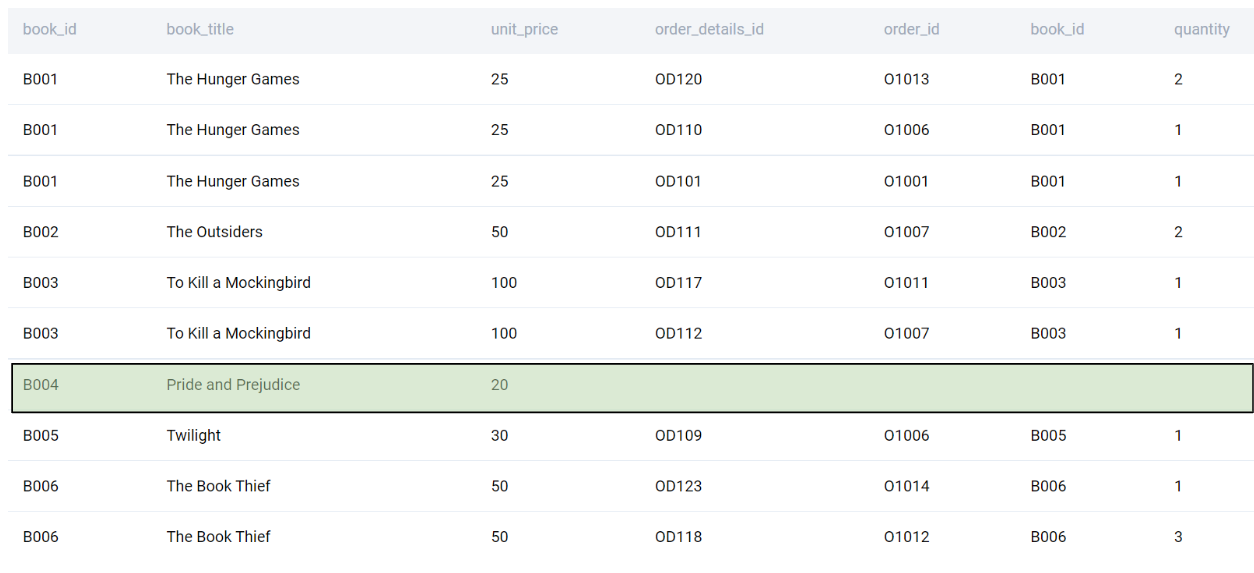
We are using LEFT JOIN, as we want to retain the books that did not have any sales as well. Now we proceed to find the total sales of the book by multiplying the unit price by the aggregate number of books sold.
SELECT
ab.book_id
, SUM(ab.unit_price * abo.quantity) AS total_sales
FROM amazon_books AS ab
LEFT JOIN amazon_books_order_details AS abo
ON ab.book_id = abo.book_id
GROUP BY 1
;
As you can see, the books with no sales have NULL or empty values. We need to replace these NULLs with 0. There are multiple ways for doing this.
IFNULL()
The IFNULL function checks if a particular value is NULL and replaces it with an alternative value.
SELECT
ab.book_id
, IFNULL(SUM(ab.unit_price * abo.quantity), 0) AS adjusted_sales
FROM amazon_books AS ab
LEFT JOIN amazon_books_order_details AS abo
ON ab.book_id = abo.book_id
GROUP BY 1
;
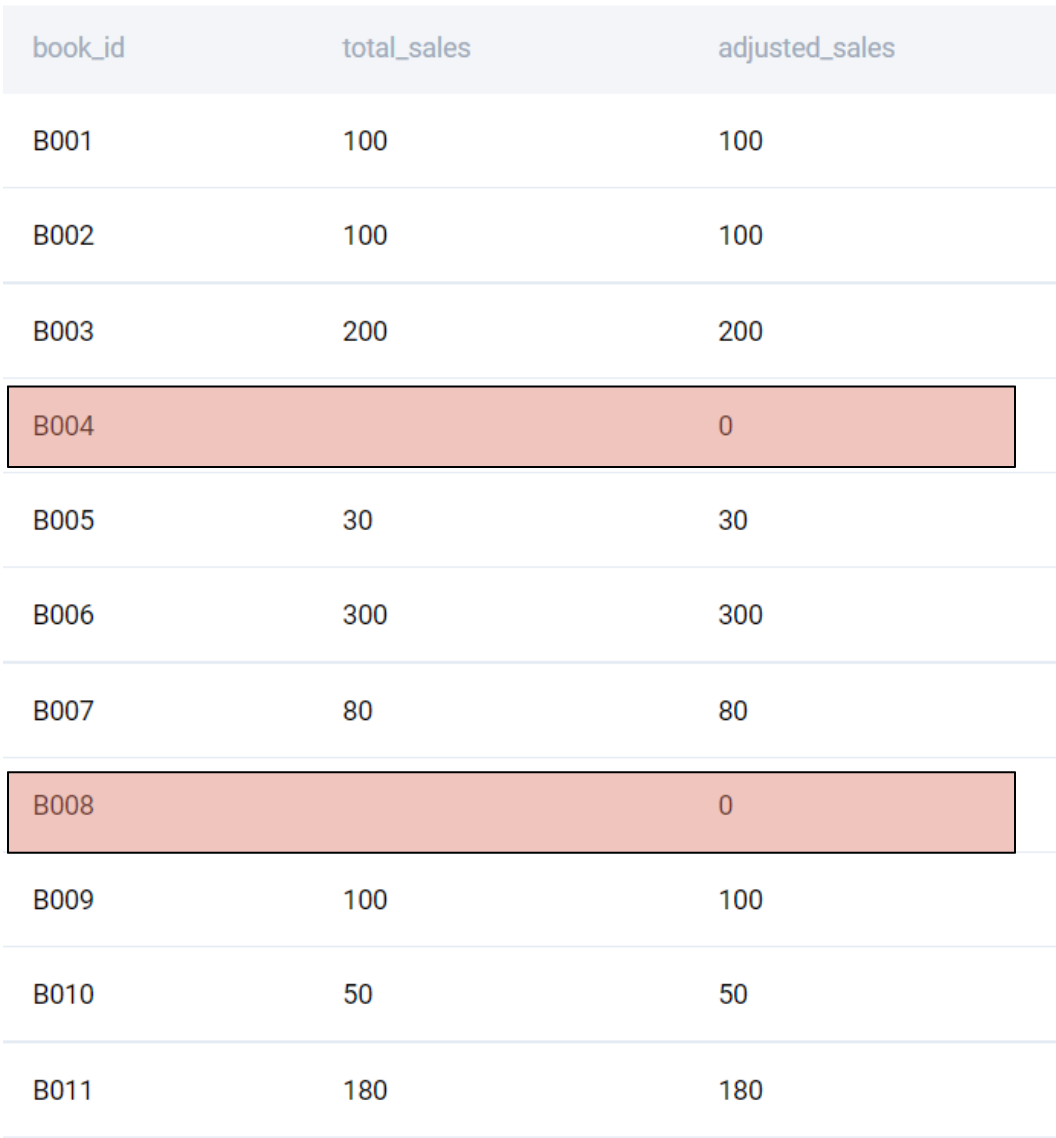
While we did not need to create an additional column, we used it to show the effect of the ISNULL function.
COALESCE
An alternate way of solving this is to use the COALESCE function. It is similar to the IFNULL function, but it works across multiple cases. The syntax is
COALESCE(value1, value2, ... valuen, default value)COALESCE will check each of the values value1, value2, … valuen and find the first non-NULL value. For example, if you try this
SELECT COALESCE(NULL, NULL, 'Alpha');it will return Alpha. As will the following COALESCE statement.
SELECT COALESCE(NULL, NULL, 'Alpha', 'Beta', NULL, 'Gamma');We can solve the given problem with COALESCE in the following manner. This will give the same result as with the IFNULL function.
SELECT
ab.book_id
, COALESCE(SUM(ab.unit_price * abo.quantity), 0) AS adjusted_sales
FROM amazon_books AS ab
LEFT JOIN amazon_books_order_details AS abo
ON ab.book_id = abo.book_id
GROUP BY 1
;
Let us try a slightly tricky problem.
MySQL Interview Question #10: Flags per Video

Link to the question: https://platform.stratascratch.com/coding/2102-flags-per-video
This problem uses the user_flags table with the following fields.

The data is presented thus.
Prima facie, this looks pretty straightforward. We need to create a unique user by concatenating the user_firstname and the user_lastname fields. To concatenate two or more values, we use the CONCAT() function. One can also use the || operator, though it is going to be deprecated soon.
SELECT
*
, CONCAT(user_firstname, user_lastname) AS user_id
FROM user_flags;
This method runs into a problem when either the first or the last name is missing. Concatenating a field with a NULL value results in a NULL value. To overcome this, we use the COALESCE function and set a default value in case we encounter a NULL in the first or the last name fields. Further, we also need to eliminate those results where the flag_id is NULL (the blue row above). We can do this by using a WHERE condition.
SELECT
*
, CONCAT(COALESCE(user_firstname, '$$'), COALESCE(user_lastname, '$$')) AS user_id
FROM user_flags
WHERE flag_id IS NOT NULL
ORDER BY 1
;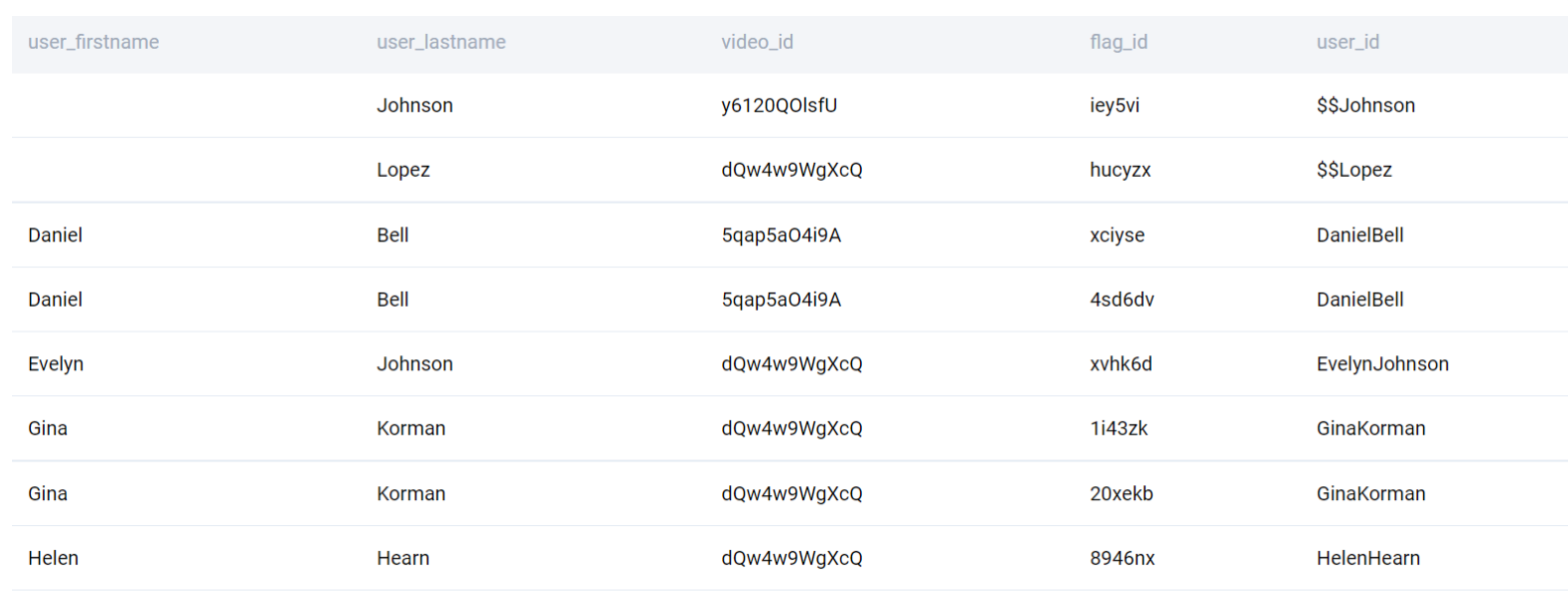
Note do not use logical operators like >, <, =, etc. with NULL. They will result in NULL.
We finish off the problem by counting the distinct users for each video.
SELECT
video_id
, COUNT(DISTINCT CONCAT(COALESCE(user_firstname, '$$'), COALESCE(user_lastname, '$$'))) AS num_users
FROM user_flags
WHERE flag_id IS NOT NULL
GROUP BY 1
;Advanced MySQL Interview Questions

Now that we have a better understanding of MySQL, let us try to learn a few advanced tricks to help solve the MySQL interview questions faster.
Using Conditional Operations
There are occasions when we want to perform calculations based on conditional values on a particular row. We have the WHERE clause that helps us subset the entire table, it is not always the most efficient way of solving a problem. Let us revisit a problem that we encountered earlier.
MySQL Interview Question #11: Extremely Late Delivery
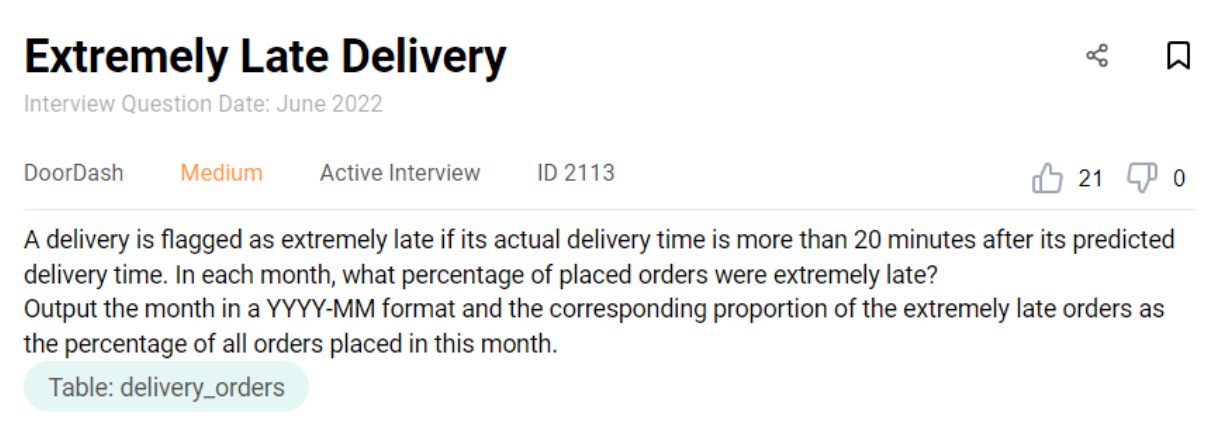
Link to the question: https://platform.stratascratch.com/coding/2113-extremely-late-delivery
The problem uses the delivery_orders table with the following fields.

The data is arranged in the following manner.
We used two CTEs and then merged them to get the final output.
WITH ALL_ORDERS AS (
SELECT
DATE_FORMAT(order_placed_time, '%Y-%m') AS YYYYMM
, COUNT(*) AS NUM_ORDERS
FROM delivery_orders
GROUP BY 1
), DELAYED_ORDERS AS (
SELECT
DATE_FORMAT(order_placed_time, '%Y-%m') AS YYYYMM
, COUNT(*) AS DELAYED_ORDERS
FROM delivery_orders
WHERE TIMESTAMPDIFF(MINUTE, predicted_delivery_time, actual_delivery_time) > 20
GROUP BY 1
)
SELECT
ao.YYYYMM
, ao.NUM_ORDERS
, do.DELAYED_ORDERS
, do.DELAYED_ORDERS / ao.NUM_ORDERS * 100
FROM ALL_ORDERS AS ao
LEFT JOIN DELAYED_ORDERS as do
ON ao.YYYYMM = do.YYYYMM
;We did this because we wanted the overall number of orders as well as the delayed orders. What if we could create a flag only for delayed orders and aggregate it separately? Conditional operators help you do exactly that. Let us look at a few conditional functions present in MySQL.
IF
As the name suggests, the IF function is the MySQL implementation of the if then else statement present in almost all programming languages. The syntax is pretty straightforward
IF(condition, value if true, value if false)For this problem, we create an additional field that returns 1 if it is a delayed order.
SELECT
DATE_FORMAT(order_placed_time, '%Y-%m') AS YYYYMM
, predicted_delivery_time
, actual_delivery_time
, TIMESTAMPDIFF(MINUTE, predicted_delivery_time, actual_delivery_time) AS time_difference
, 1 as NUMBER_OF_ORDERS
, IF(TIMESTAMPDIFF(MINUTE, predicted_delivery_time, actual_delivery_time) > 20, 1, 0) as DELAYED_ORDERS
FROM delivery_orders
;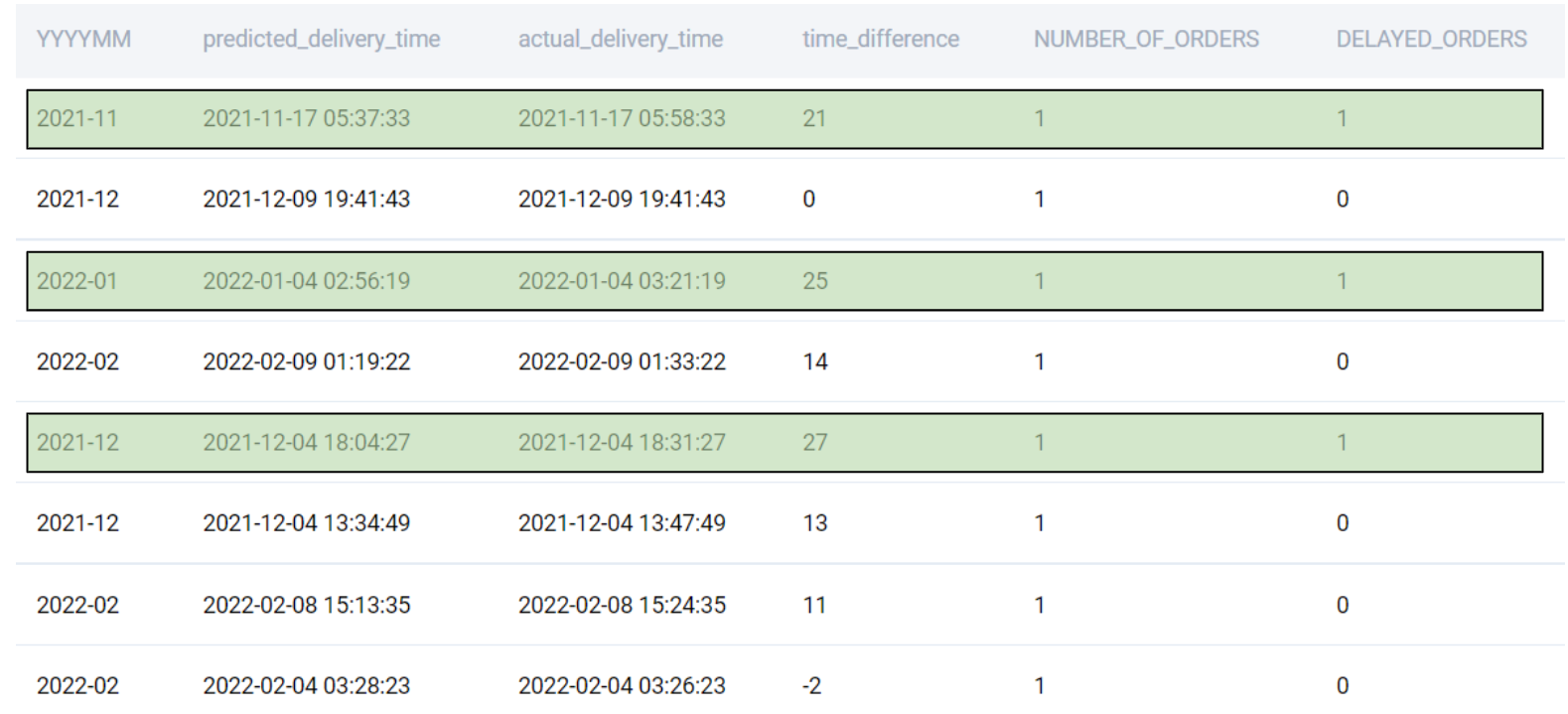
As you can see, the IF condition flags the delayed orders separately. Now we can simply aggregate these two fields to find the totals.
SELECT
DATE_FORMAT(order_placed_time, '%Y-%m') AS YYYYMM
, SUM(1) as NUMBER_OF_ORDERS
, SUM(IF(TIMESTAMPDIFF(MINUTE, predicted_delivery_time, actual_delivery_time) > 20, 1, 0)) as DELAYED_ORDERS
FROM delivery_orders
GROUP BY 1
;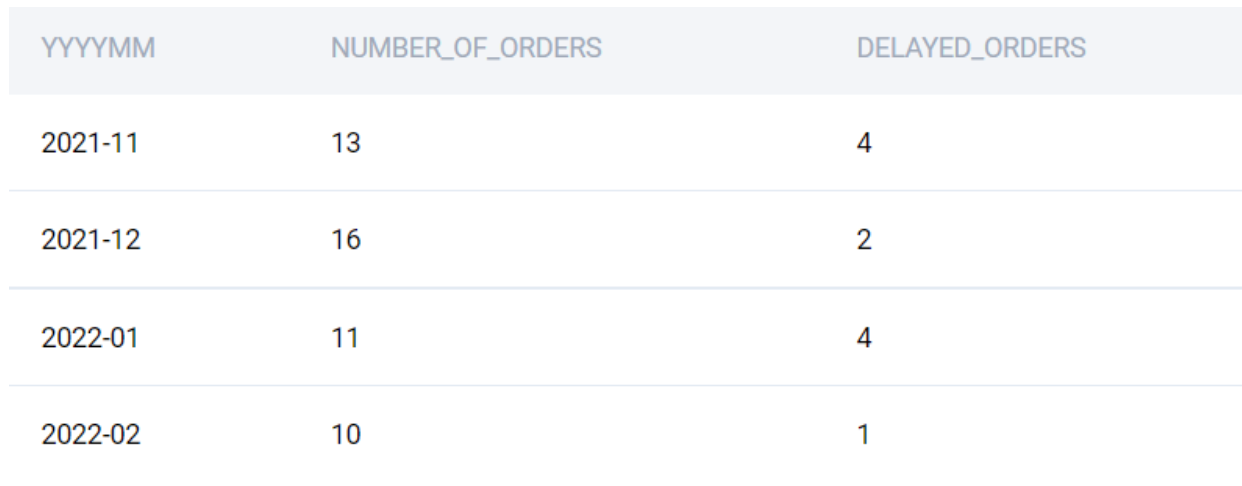
And find the portion of the delayed orders as a percentage of all orders.
SELECT
DATE_FORMAT(order_placed_time, '%Y-%m') AS YYYYMM
, SUM(IF(TIMESTAMPDIFF(MINUTE, predicted_delivery_time, actual_delivery_time) > 20, 1, 0)) / SUM(1) * 100 as PERCENTAGE_DELAYED
FROM delivery_orders
GROUP BY 1
;CASE WHEN
For more complex if then else conditions, we have the option of the CASE expression in MySQL. The CASE WHEN is capable of handling multiple conditions including complex conditions.
SELECT
DATE_FORMAT(order_placed_time, '%Y-%m') AS YYYYMM
, SUM(CASE WHEN TIMESTAMPDIFF(MINUTE, predicted_delivery_time, actual_delivery_time) > 20 THEN 1 END) / SUM(1) * 100 as PERCENTAGE_DELAYED
FROM delivery_orders
GROUP BY 1
;This gives an identical result as the IF() function.
Pivoting
Another use of conditional operators is to convert a long format table to a wide format table. This is the opposite of aggregation. This is akin to creating a pivot table in spreadsheet programs. Let us see how we can do this.
MySQL Interview Question #12: Find how the survivors are distributed by the gender and passenger classes

Link to the question: https://platform.stratascratch.com/coding/9882-find-how-the-survivors-are-distributed-by-the-gender-and-passenger-classes
This problem uses the titanic table with the following fields.

The data is presented in the following manner.
As with the previous problem, we can separately aggregate each class into multiple CTEs and then join them. However, a more efficient way to solve this problem is to tag the class of each passenger using a conditional expression. Here we use the CASE WHEN expression.
SELECT
sex
, pclass
, survived
, CASE WHEN pclass = 1 THEN survived END AS first_class
, CASE WHEN pclass = 2 THEN survived END AS second_class
, CASE WHEN pclass = 3 THEN survived END AS third_class
FROM titanic
;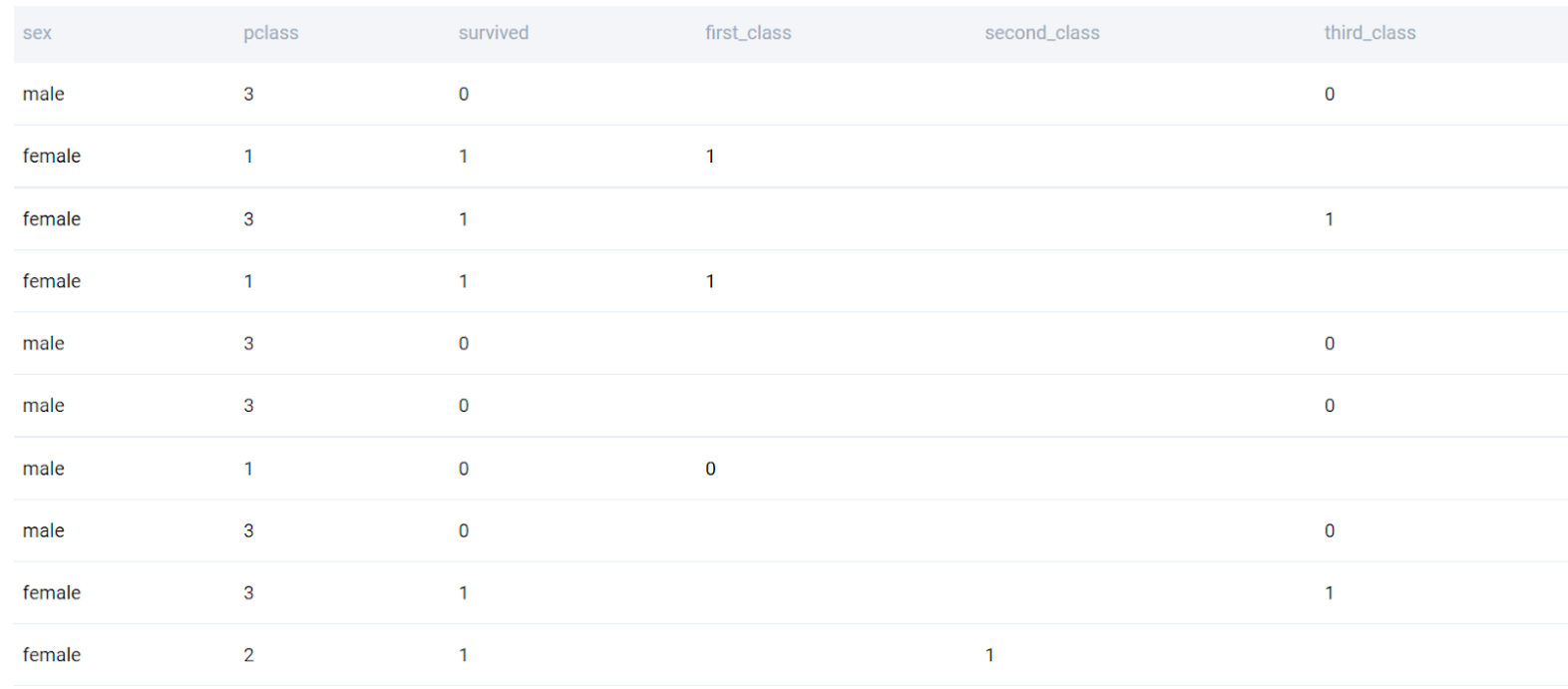
As you can observe, we have expanded the width of the table by adding columns that tag the class that the passenger was traveling in. We can now simply aggregate these columns and group them by gender.
SELECT
sex
, SUM(CASE WHEN pclass = 1 THEN survived END) AS first_class
, SUM(CASE WHEN pclass = 2 THEN survived END) AS second_class
, SUM(CASE WHEN pclass = 3 THEN survived END) AS third_class
FROM titanic
GROUP BY 1
ORDER BY 1
;Window Functions
Aggregations and CTEs can help solve a lot of problems. However, there are scenarios where one wishes we could do both at the same time. Let us take this problem.
MySQL Interview Question #13: First Ever Ratings

Link to the question: https://platform.stratascratch.com/coding/2114-first-ever-ratings
This problem uses the delivery_orders table with the following fields.
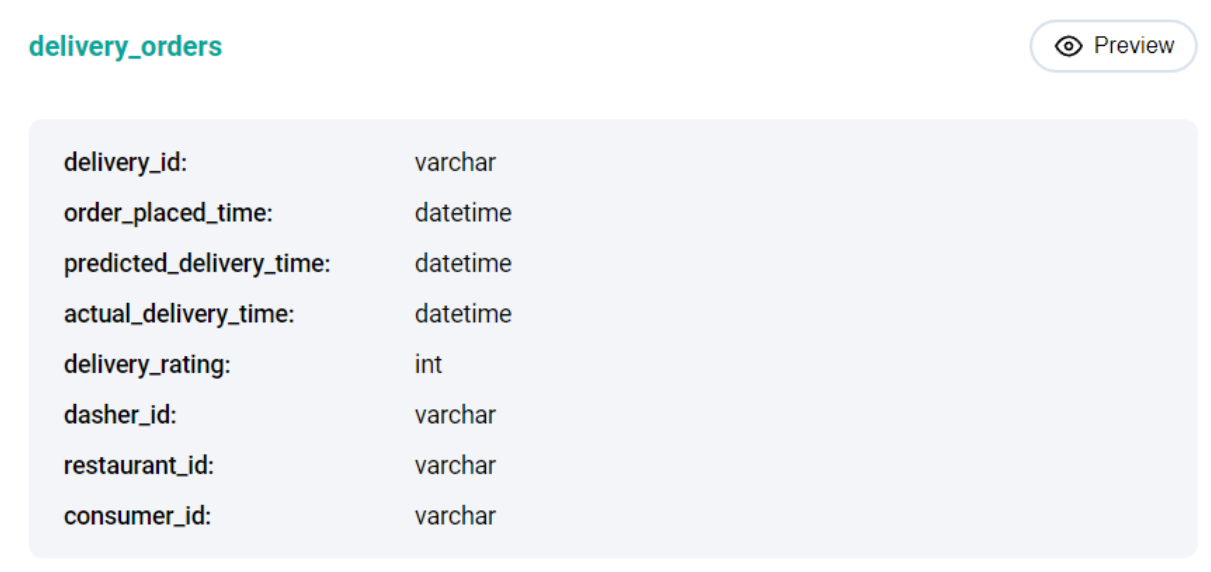
The data is presented in the following manner.
The key to solving this problem is to identify the first order for each driver and exclude the canceled orders. Once that is identified, we can use a CASE WHEN expression to separate out the drivers with the first delivery rating as zero. Let us try to identify the first order. We can try using a CTE or sub-query to find the first order timestamp and merge it back to the dataset to find the first order. Something like this.
WITH first_order_ts AS (
SELECT
driver_id
, MIN(actual_delivery_time) as first_order_timestamp
FROM delivery_orders
WHERE actual_delivery_time IS NOT NULL
GROUP BY 1
)
SELECT
do.driver_id
, do.delivery_id
, do.delivery_rating
, do.actual_delivery_time
, CASE WHEN fo.driver_id IS NOT NULL THEN 1 ELSE 0 END AS is_first_order
FROM
delivery_orders AS do
JOIN first_order_ts AS fo
ON do.driver_id = fo.driver_id
AND do.actual_delivery_time = fo.first_order_timestamp
;

Now it is pretty easy to find the required output. We’ll use CASE WHEN, SUM(), and COUNT() in the main query and remove all the unnecessary columns we used in the above query.
WITH first_order_ts AS (
SELECT
driver_id
, MIN(actual_delivery_time) as first_order_timestamp
FROM delivery_orders
WHERE actual_delivery_time IS NOT NULL
GROUP BY 1
)
SELECT
ROUND((SUM(CASE WHEN do.delivery_rating = 0 THEN 1 ELSE 0 END) / COUNT(*)) * 100, 2) AS percentage_of_zero_rating
FROM
delivery_orders AS do
JOIN first_order_ts AS fo
ON do.driver_id = fo.driver_id
AND do.actual_delivery_time = fo.first_order_timestamp
;
But what if we had to find the rating for the second order? While it is possible to create CTEs for this, it is going to be complicated. Enter window functions. Window functions work across different table rows like aggregation functions, but they retain the original rows without aggregating them. The rows still retain their separate identities. Let us try to solve this using a window function.
WITH ranked_orders AS (
SELECT
driver_id
, delivery_id
, actual_delivery_time
, delivery_rating
, ROW_NUMBER() OVER (PARTITION BY driver_id ORDER BY driver_id, actual_delivery_time) AS order_rank
FROM delivery_orders
WHERE actual_delivery_time IS NOT NULL
)
SELECT
*
FROM ranked_orders
;
As you’ll notice in the output, every driver’s orders are ranked separately.
WITH ranked_orders AS (
SELECT
driver_id
, delivery_id
, actual_delivery_time
, delivery_rating
, ROW_NUMBER() OVER (PARTITION BY driver_id ORDER BY driver_id, actual_delivery_time) AS order_rank
FROM delivery_orders
WHERE actual_delivery_time IS NOT NULL
)
SELECT
*
FROM ranked_orders
LIMIT 6
;
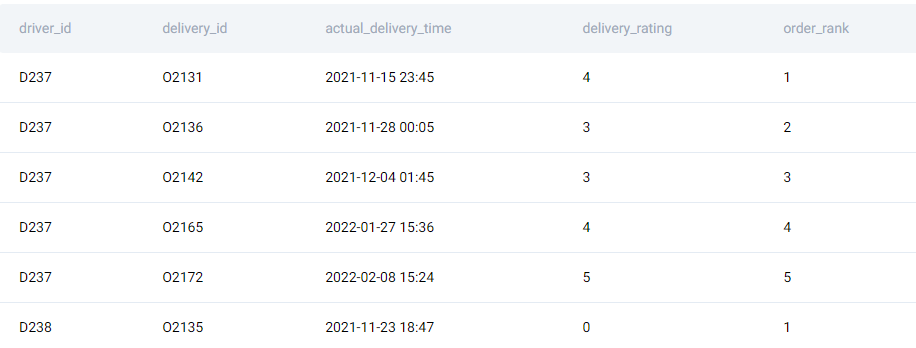
This gives an elegant way of ordering the rows as well as ranking them without resorting to aggregations. Now the problem becomes a simple application of the CASE WHEN expression.
WITH ranked_orders AS (
SELECT
driver_id
, delivery_id
, actual_delivery_time
, delivery_rating
, ROW_NUMBER() OVER (PARTITION BY driver_id ORDER BY driver_id, actual_delivery_time) AS order_rank
FROM delivery_orders
WHERE actual_delivery_time IS NOT NULL
)
SELECT
COUNT(DISTINCT CASE WHEN order_rank = 1 AND delivery_rating = 0 THEN driver_id END)
/ COUNT(DISTINCT CASE WHEN order_rank = 1 THEN driver_id END) * 100.0 as pct
FROM ranked_orders
;
The code above gives answer to our particular question. However, the solution is customizable. One can find the percentages for the second or fifth on any other rank very easily. This is a simple application of window functions. We can apply them in many more complex cases. You can read our Ultimate Guide to SQL Window functions here to learn more about them.
Conclusion
MySQL is a powerful database tool and is widely used across different industries. If you are experienced in other SQL flavors like Postgres, Oracle, etc., you can easily switch over to MySQL. Remember to use the documentation generously. If you are starting out on your SQL journey, MySQL is a good place to start. As with any other skill in life, all one needs to master is patience, persistence, and practice. On the StrataScratch platform, you will find over 600 real-life interview problems involving coding in SQL (MySQL and Postgres) and Python. Sign up today and join a community of over 20,000 like-minded aspirants and helpful mentors to help you on your mission to join top companies like Microsoft, Apple, Amazon, Google, et al.
Share


